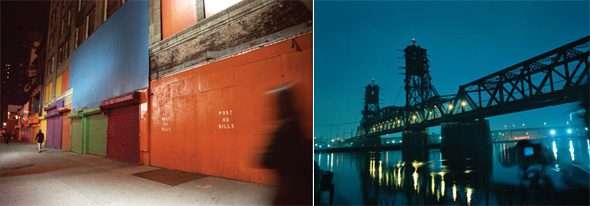photography
Bright Nights
Photographer Lynn Saville sees New York City in a certain light
by Nicole Pezold / GSAS ’04

Photographer Lynn Saville generally works alone. With a small, collapsible tripod and two cameras, she scouts New York City’s unpopulated, weed-choked fringes, from Gowanus in Brooklyn to Hunts Point in the Bronx, by both bus and foot. She may wander up and down a desolate block absorbed by angles and, especially, points of illumination. She shoots at twilight, when the sky fades in cinematic tension with freshly lit street lamps and floodlights. “I feel drawn to these places that seem almost pastoral, that had been industrial and now things are shifting; forgotten unloved places,” Saville explains.
Unloved they may be, but Saville’s lens, as revealed in her recent book Night/Shift (Monacelli), bestows them with an unexpected beauty. Luminous blues, from desert turquoise to cobalt, accented with pinks, oranges, and amber, highlight empty rail yards, loading docks, shells of warehouses, the bellies of overpasses, and elevated subway platforms. Saville admits she felt some urgency to record these streetscapes because—even in the midst of a recession—it seems only a matter of time before they’re claimed for condos, bank branches, and Duane Reades. “I love the way the city looks now and have this fear that developers will come and collapse whole blocks and put up something anonymous,” she says. Saville, who co-teaches the “New York at Twilight” course with night photographer Kay Kenny at the School of Continuing and Professional Studies, has amassed two decades worth of nighttime images, much of them focused on the city’s architecture, and pieces from her oeuvre grace the collections of the Brooklyn Museum and the New York Public Library. Art critic Arthur Danto, in Night/Shift’s introduction, compares her to Eugène Atget, the ambitious photographer who documented Paris’s empty streets in the early 20th century.
Saville is no preservationist. She was trained at the Pratt Institute as a street photographer. In the vein of celebrated artists André Kertész and Garry Winogrand, she set out to capture the experience of street life at random moments—but was drawn to the urban landscape instead. She credits her fascination with light to a drawing class, where a model was sitting under a spotlight. The assignment was to fill a piece of paper with charcoal and then erase to find the image. “It was a major moment for me,” Saville says, to realize one could bring light out of dark. Ever since, she has tried to replicate that grainy contrast in her photos. In her 1997 book, Acquainted With the Night (Rizzoli), this aesthetic lent a film noir look to black-and-white images of New York and far-flung places such as Greece and India.
Recently, Saville has started to confront a problem: people walking into her shots. As she was snapping “39 Washington Street,” in the DUMBO section of Brooklyn for her latest book, a young woman in a white dress hurried into the shadows of the frame. At first Saville was annoyed, but sifting through the negatives she realized that this ethereal figure made the picture. Her next project is to capture more of these sorts of anonymous interlopers. Some neighborhoods, however, are now so clogged with foot traffic that they no longer lend themselves as subjects. Today it would be impossible to re-create “West 42nd Street,” taken just off Times Square in 1998. In the photograph, a wall of shabby, rainbow-shuttered businesses looms at the viewer, while a leggy woman, likely a prostitute, sashays into the background. “I was actually scared that someone was going to mug me,” Saville remembers of the shoot. “Now the problem is somebody will trip over your tripod.”
Saville is represented by Yancey Richardson Gallery.







